Your living room bookshelf isn’t just for storing books—it’s a chance to showcase your personality and elevate your decor! Stylish and functional, bookshelf decor ideas have gained popularity because they turn an everyday element into a focal point that reflects your unique taste.
In this article, you’ll find a variety of creative ideas to transform your bookshelf into a stunning display. From curated collections and decorative accents to innovative arrangements, these tips will inspire you to make your living room both beautiful and personal.
1. Arrange Books by Color for a Stunning Rainbow Effect
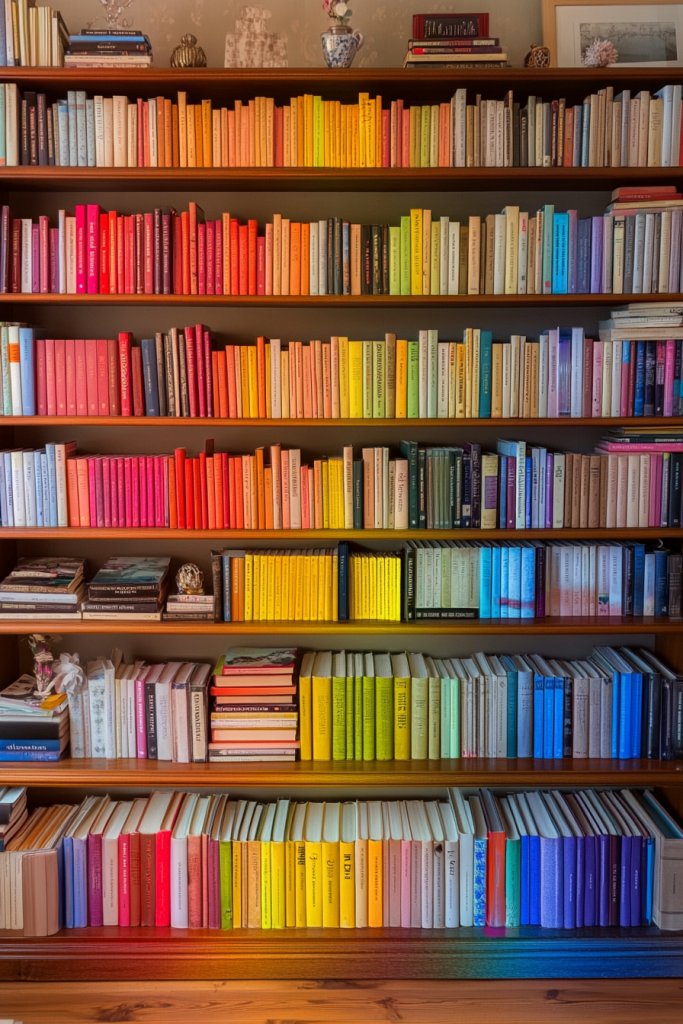
Ever stared at a chaotic bookshelf and felt overwhelmed by the jumble of colors and titles? Organizing books by color offers a simple yet striking solution to turn your collection into a visual masterpiece. It transforms a cluttered space into an eye-catching display that feels intentional and polished. Plus, it makes finding that next read a little more fun when everything’s in rainbow order.
Imagine a wall of books where each spine aligns to create a vibrant gradient, from deep blues to fiery reds. The glossy covers catch the light, casting a subtle sheen that draws the eye. The organized spectrum creates a sense of harmony, making your shelf appear like a work of art. It’s almost like having a living, breathing piece of abstract decor embedded in your room.
You can adapt this idea to match your personal color preferences—go monochrome for sleek minimalism or a bold rainbow for playful energy. Seasonal swaps are easy: swap out books to match the changing hues of the seasons or your mood. For smaller spaces, use this technique on a single shelf or a corner to keep things balanced. Even black-and-white or pastel themes work for a softer aesthetic.
Start by grouping your books by dominant color tones. Remove all books and organize them into color piles. Carefully align the spines so that their colors flow smoothly from one to the next. Use a level or a straight edge to keep everything aligned horizontally. For a more permanent setup, you can use clear adhesive strips or thin spacers to keep books in place, but be cautious not to damage the spines.
Add a few decorative objects in neutral tones or metallic finishes to break up the color spectrum. Consider labeling certain sections with minimalist tags or subtle symbols that match your theme. Incorporate a soft throw blanket or textured fabric along the top or side for added warmth and tactile contrast. These small touches make your rainbow shelf uniquely yours.
Turning your bookshelf into a rainbow display not only elevates your decor but also boosts your mood every time you glance at it. It’s a fun project that combines creativity with organization—perfect for those who love vibrant aesthetics. Once done, you’ll enjoy a sense of pride knowing your collection doubles as a piece of art and a practical storage solution.
2. Incorporate Stylish Bookends to Add Visual Interest
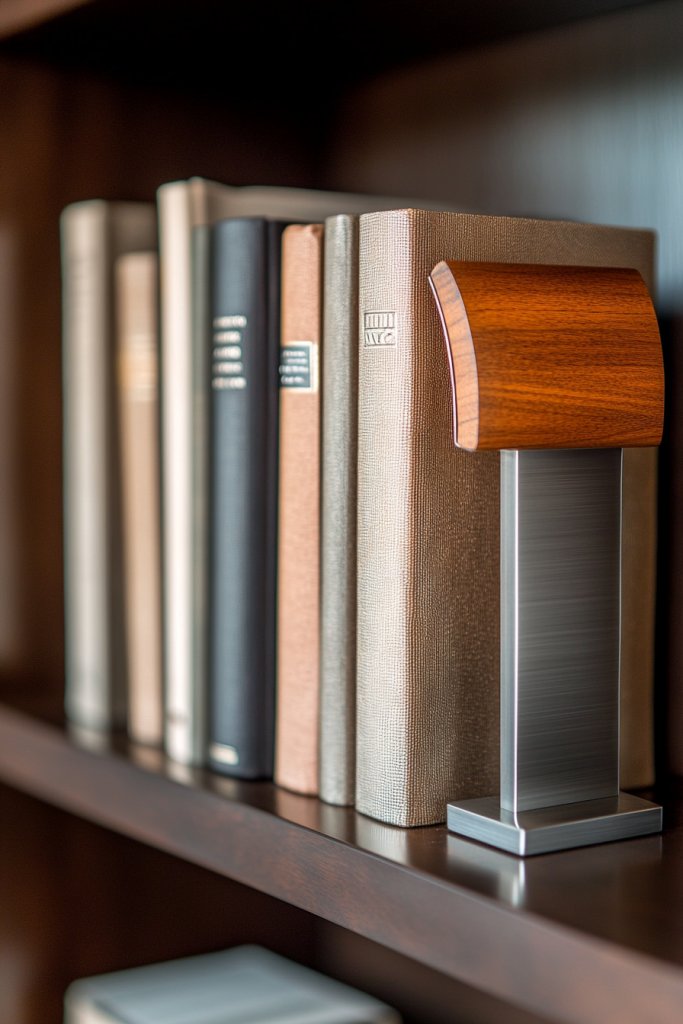
Is your bookshelf looking a little bare or disorganized? Adding stylish bookends instantly elevates the look while keeping your books upright and accessible. They serve as decorative accents that reflect your personality and tie your decor theme together. Who knew a simple accessory could make such a difference?
Picture a row of books held in place by sleek, geometric metal bookends that catch the light with a modern shine. Or imagine whimsical ceramic figures peeking out from between stacks of novels, adding a touch of humor and charm. The right bookends can introduce textures, shapes, and even metallic finishes that contrast with your books’ covers.
Choose minimalistic metal or acrylic pieces for a contemporary vibe, or go for vintage brass and ornate ceramics to evoke nostalgia. For themed decor, match your bookends to your room’s style—think rustic wood for farmhouse or glossy black for industrial. Change them seasonally or for special occasions to keep things fresh. Mix different shapes and sizes for an eclectic look.
Select bookends that are sturdy enough to support your collection without tipping over. Position them at either end of a row or intersperse them among books for a more layered appearance. If you’re feeling crafty, DIY your own using materials like concrete, wood, or repurposed objects. Ensure they don’t scratch your shelves by adding felt pads or rubber feet underneath.
Personalize your bookends by customizing with paint, decals, or engraved initials. Use themed sets—such as travel icons, animals, or abstract shapes—that complement your decor style. Combine different materials to create a mixed-media look, like metal with wood or ceramic with glass. These small details can make your shelf uniquely yours.
Stylish bookends are an easy way to showcase your taste and keep your books organized at the same time. They add a layer of personality and can become conversation starters. Plus, they make your bookshelf look curated rather than cluttered. Once you see the difference, you’ll wonder how you ever managed without them.
3. Mix Open Shelving with Hidden Storage for Practicality
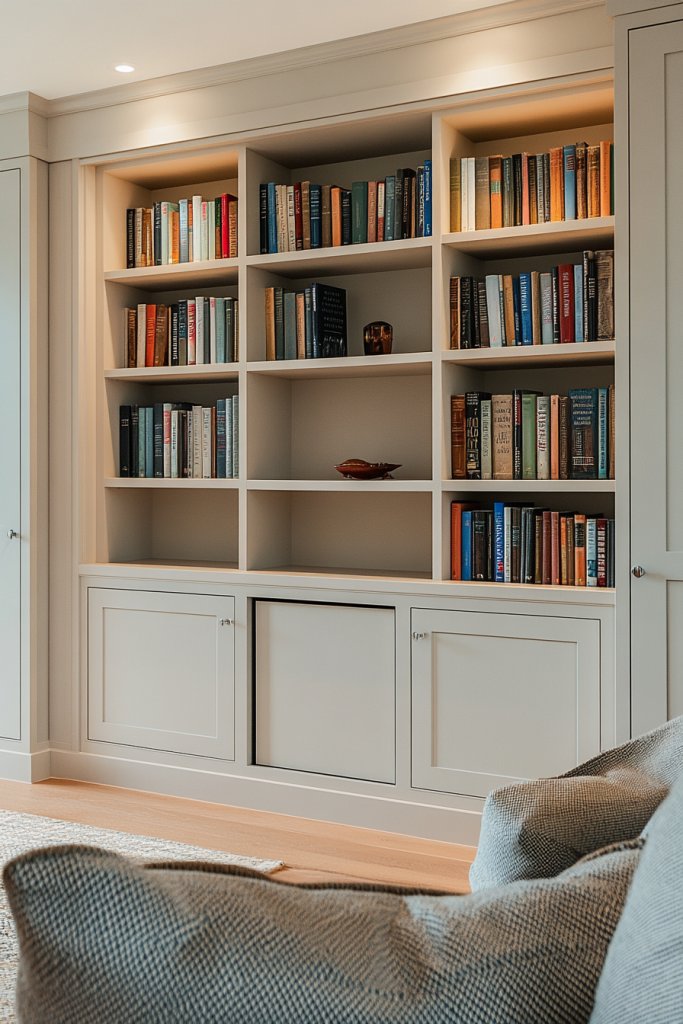
Do you find your living room cluttered despite having a bookshelf? Combining open shelving with hidden storage offers a practical way to show off your favorite books while keeping other items out of sight. It strikes a balance between display and discretion, making your space look curated and tidy. Who says storage can’t be stylish?
Envision a sleek open shelf filled with your favorite books, artful objects, and decorative accents. Below, a concealed drawer or cabinet hides away less attractive clutter—remote controls, extra chargers, or miscellaneous odds and ends. The exposed shelves highlight your prized possessions, while the hidden compartments keep the rest neatly tucked away. It’s a balanced mix of form and function.
Opt for cabinetry with a minimalist design that blends seamlessly with your existing furniture. Use open shelves for decorative books or collectibles, and choose hidden storage options for everyday clutter. In small spaces, this setup prevents visual overload, keeping things simple and organized. Seasonal decor can be swapped easily on open shelves, while the hidden storage remains functional year-round.
Start by assessing what items need hiding versus what can be displayed. Invest in open shelving units with built-in cabinets or add custom cabinetry to existing shelves. Use baskets, fabric-lined drawers, or sliding doors to conceal clutter. Keep frequently used items accessible in the hidden compartments, and reserve open shelves for eye-catching objects or books. Organize efficiently to maximize space.
Add decorative labels or tags to the hidden storage for easy identification. Incorporate textured or patterned baskets to add visual interest. Use lighting inside cabinets or drawers to make accessing items easier and more appealing. Pair the storage with decorative trays or stands on open shelves to create visual layers and maintain order.
This hybrid approach provides a clutter-free, stylish look that’s perfect for busy households. It shows that smart storage solutions can be both practical and attractive. Once you see how much tidier your space feels, you’ll be motivated to adopt similar strategies throughout your home. It’s all about creating a space that works for your lifestyle and aesthetic.
4. Use Floating Shelves for a Minimalist and Modern Vibe
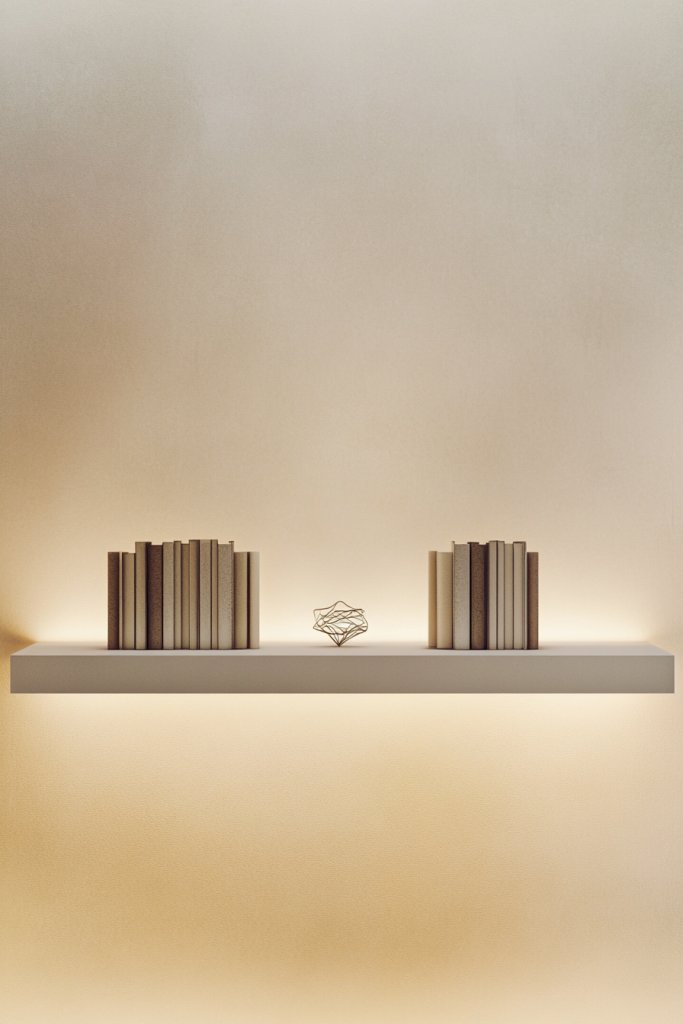
Tired of bulky furniture blocking your walls? Floating shelves offer a sleek, minimalist alternative that maximizes vertical space. They provide a modern aesthetic that’s clean, uncluttered, and ideal for showcasing select books or decorative objects. Plus, they make your room feel more open and airy.
Imagine a set of slim, matte-finished floating shelves mounted seamlessly against a neutral wall. The shelves hold a curated collection of books, textured ceramics, or small sculptures. The absence of visible brackets creates a floating illusion, giving your room a contemporary, uncluttered look. Subtle lighting behind the shelves can accentuate their clean lines and add ambiance.
Use varying lengths and heights for visual interest, or keep the same size for a uniform look. Mix materials—wood, metal, or glass—for different textures and styles. For a more personalized touch, stagger the shelves or install them asymmetrically to create a dynamic display. Seasonal or themed decor can be layered in for variety without crowding the space.
Measure your wall space carefully before installing. Use a level and secure anchors to ensure stability. Install the brackets or mounting hardware first, then slide the shelves into place—many are designed for easy assembly. Arrange your books and objects thoughtfully, balancing color and size for harmony. Keep weight limits in mind to prevent sagging or damage.
Add LED strip lighting underneath or behind the shelves for a soft glow that highlights your display. Incorporate decorative objects like vintage cameras, textured boxes, or unique collectibles to add personality. Change the arrangement seasonally to keep your decor fresh. Use contrasting colors or finishes to match your room’s overall style.
Floating shelves are a versatile upgrade that makes any living space feel more modern and intentional. They’re easy to update as your tastes evolve, and they keep your walls looking sleek. Once installed, you’ll appreciate how such a simple addition can dramatically change the room’s vibe, inspiring you to experiment more with your decor.
5. Incorporate Unique Vintage or Antique Books as Decorative Accents
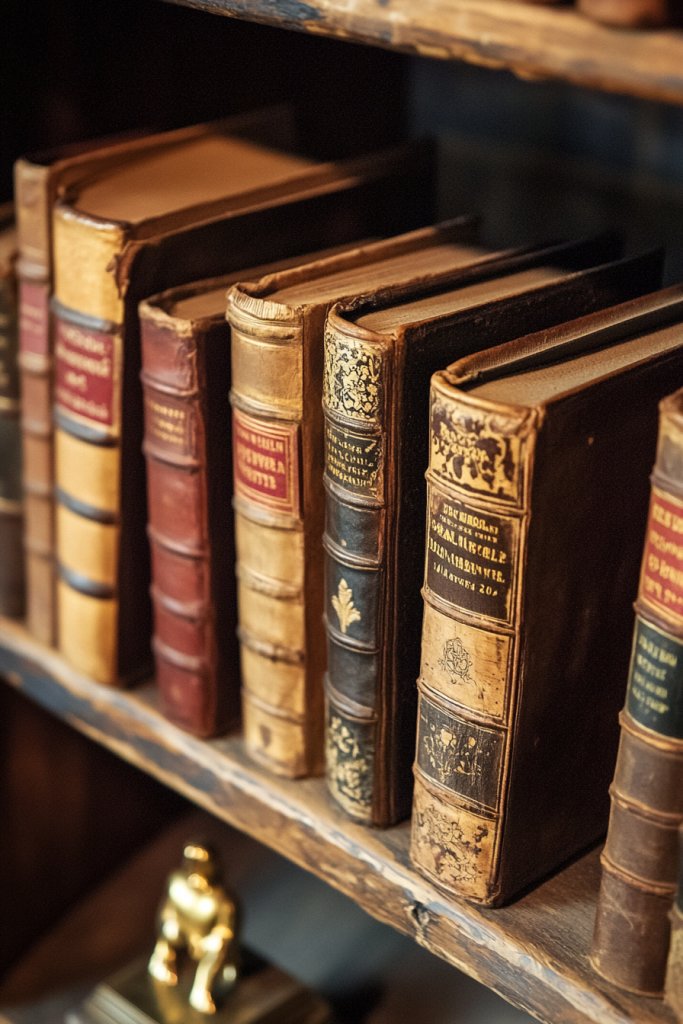
Looking to add character and history to your living room? Vintage or antique books serve as beautiful decorative accents that also tell a story. They instantly elevate your shelf’s aesthetic while adding a touch of nostalgia. Who wouldn’t want a little piece of history right in their home?
Visualize a shelf where ornate, leather-bound books with gilded edges stand alongside modern covers. The aged pages and intricate covers add texture and richness to your decor. Sometimes, stacking a few of these old treasures horizontally creates visual weight and contrast against newer titles or minimalist decor. These books become conversation pieces and mood setters.
Use antique books sparingly as focal points or blend them with contemporary volumes for an eclectic look. Display them with other vintage objects like cameras or decorative boxes for a curated vibe. For seasonal decor, pair antique books with seasonal textiles or special artifacts. Keep the older books in good condition by handling carefully and avoiding direct sunlight.
Source vintage or antique books from flea markets, online marketplaces, or specialized shops. Look for titles and covers that resonate with your style or add historical intrigue. Mix these with regular books or display them prominently on open shelves. You can also create a small vignette by stacking a few books and topping them with a decorative object or a small sculpture.
Personalize your vintage collection by adding custom bookplates or handwritten notes inside the covers. Incorporate them into larger displays with complementary objects like antique clocks or textured fabrics. Use their aged appearance to inspire your room’s color palette—think warm neutrals and rich, earthy tones. Rotate your vintage collection periodically for a fresh look.
Vintage books add depth, charm, and a sense of history that can’t be replicated. They make your space feel curated and personal, showcasing your unique taste. With a little effort, you can create a library that’s as much about storytelling as it is about style, inspiring curiosity and admiration in visitors.
6. Add Small Decorative Objects Interspersed Among Books
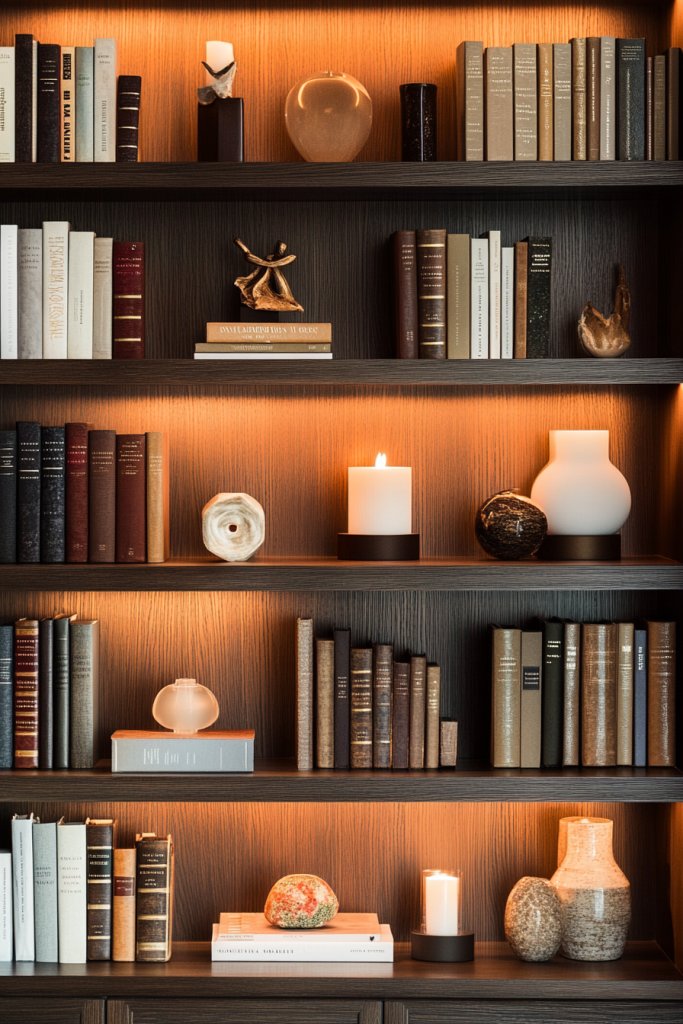
Is your bookshelf looking a bit plain or monotonous? Small decorative objects can break up the sea of books and inject personality into your display. They add layers of visual interest and make your shelf feel intentional rather than cluttered. Plus, they can reflect your hobbies or style preferences.
Picture tiny sculptures, figurines, or textured objects nestled among colorful books. A small ceramic owl perched atop a stack, or a geometric metal sculpture leaning against a row of novels, creates a curated look. These accents introduce contrasting textures and shapes, making the overall display more dynamic. They can be tactile, adding a sensory dimension to your decor.
Choose objects that resonate with your personality or decor theme—think natural stones for earthy vibes or metallic accents for modern glam. Change or rotate objects seasonally to keep the display fresh. Use trays or shallow bowls to group small objects for a neat appearance. Mix and match different shapes, sizes, and materials for an eclectic, personalized look.
Select objects that are proportionate to your shelf space—nothing too large or small that they get lost or overwhelm. Place them strategically between books or at shelf ends for balance. To avoid clutter, keep a limited number of objects and allow breathing space. Use adhesive putty or museum gel to secure delicate items if needed, but be careful not to damage surfaces.
Create themed vignettes with objects that tell a story—like travel souvenirs or vintage collectibles. Incorporate textured elements like woven baskets or soft fabrics nearby to add tactile interest. Personalize with small framed photos or engraved keepsakes. Remember, less is more—focus on quality and meaning rather than quantity.
Adding small objects makes your collection feel curated and lively. They reflect your personality and turn a simple shelf into a mini-museum of your life and interests. Once you see how these accents transform your space, you’ll be encouraged to experiment more and refine your decor style.
7. Create a Themed Display for Cohesion and Style
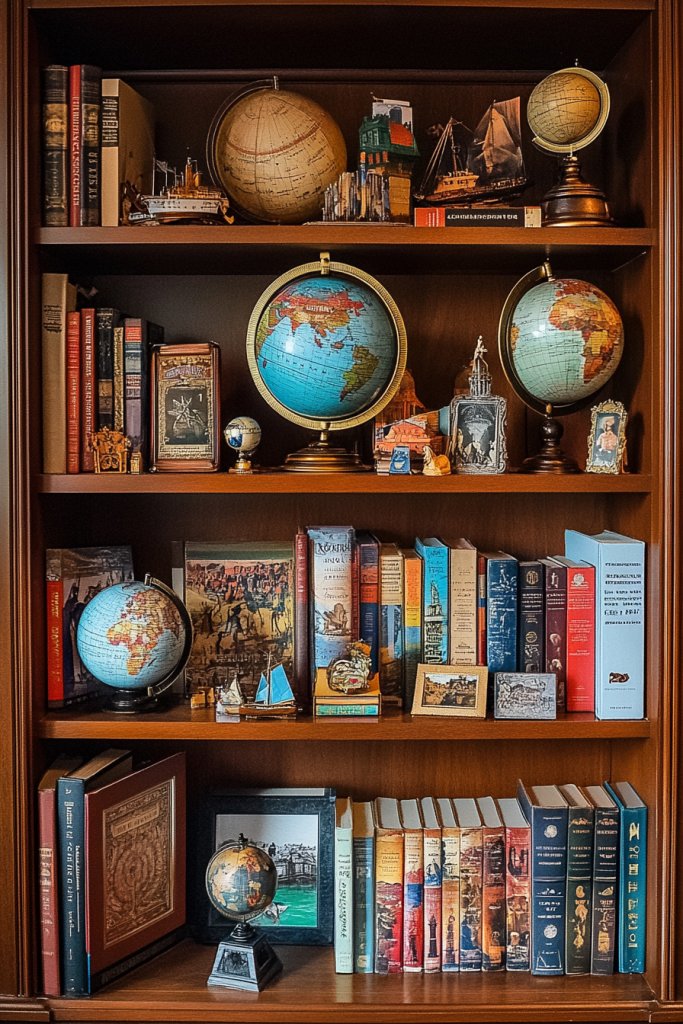
Ever feel like your bookshelf is a random collection rather than a curated display? Creating a themed setup can bring cohesion and elevate your decor. It helps tell a story—whether it’s travel, art, or minimalism—and makes your space feel intentional. Who doesn’t love a room that looks thoughtfully designed?
Imagine a shelf where all items revolve around a specific theme—like vintage travel, botanical illustrations, or monochrome elegance. Books, objects, and accents all work together harmoniously, reinforcing the concept. For example, a travel-themed shelf might feature old maps, postcards, and travel guides alongside related books. The overall look sparks curiosity and invites exploration.
Choose a theme that resonates with your personality and room style. Mix media—combine books, textiles, and curated objects—to deepen the theme. Seasonal themes, like cozy winter or beach summer, are easy to switch out. Keep the color palette consistent to strengthen the visual narrative. You can also adapt the theme to fit your space constraints by focusing on a single shelf or corner.
Define your theme and gather matching objects, books, and accessories. Arrange your items in a way that creates a balanced visual flow—consider symmetry or asymmetry based on your style. Use stacks of books and layered objects to add depth. Regularly refresh the display with new items or swapped accessories for ongoing interest. Keep clutter minimal to maintain clarity.
Add custom labels or tags that fit the theme for a handcrafted touch. Use matching storage boxes or baskets that align with the decor style. Incorporate small, themed textiles like throws or cushions nearby to complement the display. This approach makes your bookshelf a mini gallery that reflects your passions.
A themed display transforms an ordinary shelf into a storytelling centerpiece. It demonstrates your creativity and attention to detail. As you develop your style, your confidence in curating meaningful decor will grow, inspiring you to tackle other areas of your home with similar passion.
8. Use Adjustable Shelves to Vary Heights and Depths
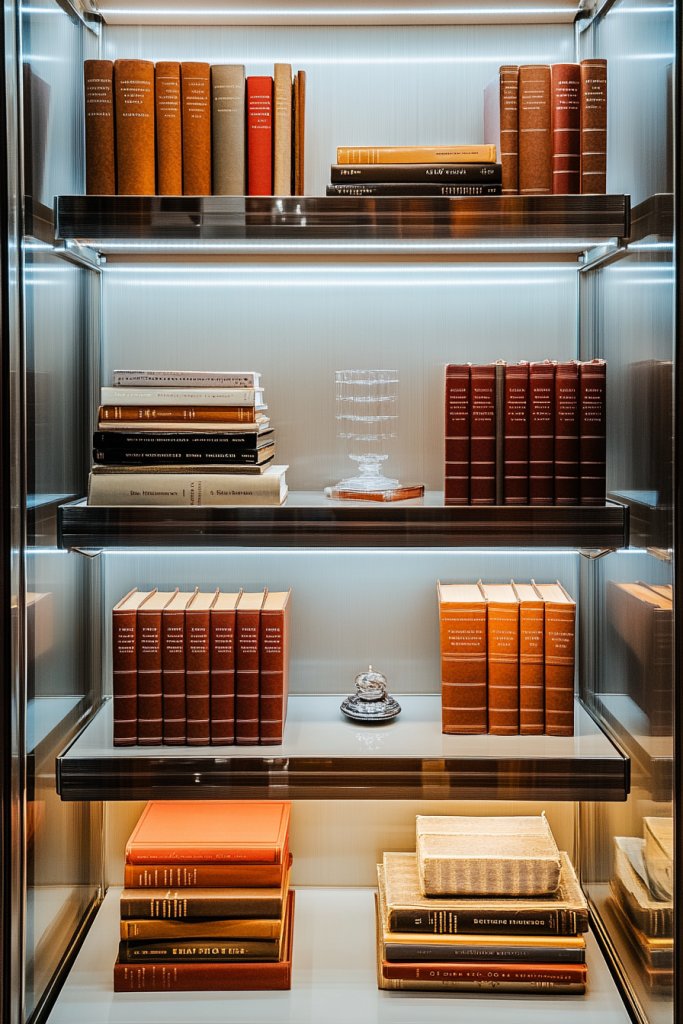
Do your books and objects look flat and monotonous on fixed-height shelves? Adjustable shelving gives you the flexibility to create visual interest through varied heights and depths. It allows you to customize your display for different-sized items and avoid a boring, uniform look. Who knew customization could be so simple?
Envision a shelf with sections at different heights—some tall enough for large art books, others shallow for small collectibles. This variation adds rhythm and movement to your display, preventing it from looking static. The play of light and shadow on different levels emphasizes your curated collection, making it more engaging.
Use adjustable shelves for different seasons or changing collections—swap out taller books for smaller ones as needed. Combine fixed and adjustable elements for a dynamic look. For small spaces, create mini vignettes at different heights to maximize visual impact without overcrowding. It’s a versatile approach that adapts easily to evolving tastes.
Select shelving units with adjustable brackets or tracks that allow height modifications. Install them securely into your wall or existing furniture. Arrange your books and objects at different levels, balancing weight and visual weight. Use risers or small blocks beneath objects to fine-tune their height if needed. Regularly refine the arrangement for best balance.
Use color or material contrasts between shelves to highlight specific sections. Incorporate decorative objects at varied heights for added dimension. Consider installing LED lighting at different levels to accentuate your display. Add small, movable accessories that can be repositioned as your collection grows or changes.
Varying shelf heights opens up endless possibilities for creative layouts. It makes your display more lively and tailored to your collection. As you experiment, your confidence in designing personalized spaces increases, inspiring you to explore even more innovative decor ideas.
9. Incorporate Framed Photographs or Personal Memorabilia
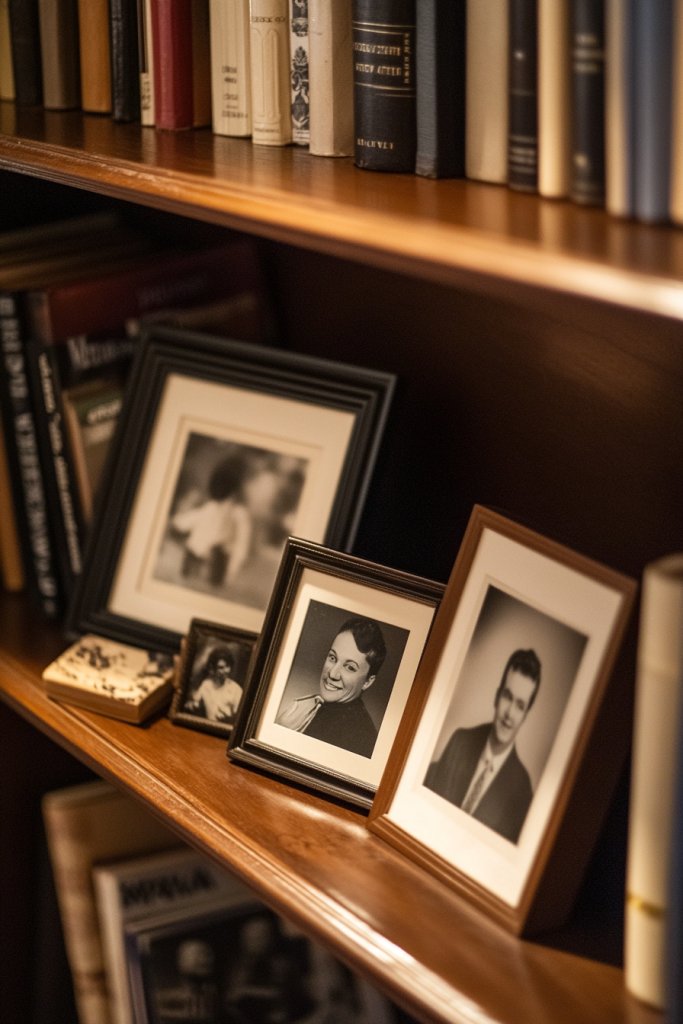
Want to turn your bookshelf into a personal showcase rather than just a storage unit? Including framed photographs or memorabilia makes your space uniquely yours. It adds warmth and personality, turning an ordinary shelf into a storytelling display. Who doesn’t want their home to feel more personal?
Picture a shelf where framed family photos, travel souvenirs, or sentimental keepsakes sit alongside books. The frames add structure and focus, drawing attention to special moments. Mixing in personal items creates a layered, lived-in look that invites conversation and connection.
Use a mix of frame styles—modern, vintage, or handcrafted—to match your decor. Incorporate memorabilia from different life stages or experiences for a rich narrative. Rotate pieces seasonally or for special occasions to keep the display fresh. Keep the arrangement balanced with books and objects to prevent clutter.
Select meaningful items and frame or display them with care. Position them at eye level or at focal points to draw attention. Use stands or small easels for memorabilia that can’t be framed. Incorporate small ledges or clipboards for a flexible, changeable setup. Group related items to tell a cohesive story.
Add decorative borders, mats, or decals to the frames for extra flair. Personalize memorabilia with handwritten notes or labels. Create a visual flow by pairing photos with related objects—like a travel photo with a souvenir. This personal touch makes your bookshelf a reflection of your life.
Personal memorabilia foster a sense of belonging and pride. They turn your space into a reflection of your journey and memories. As you curate these displays, you’ll feel more connected to your home and confident in showcasing your unique story.
10. Highlight Favorite Titles with Spot Lighting or LED Strips
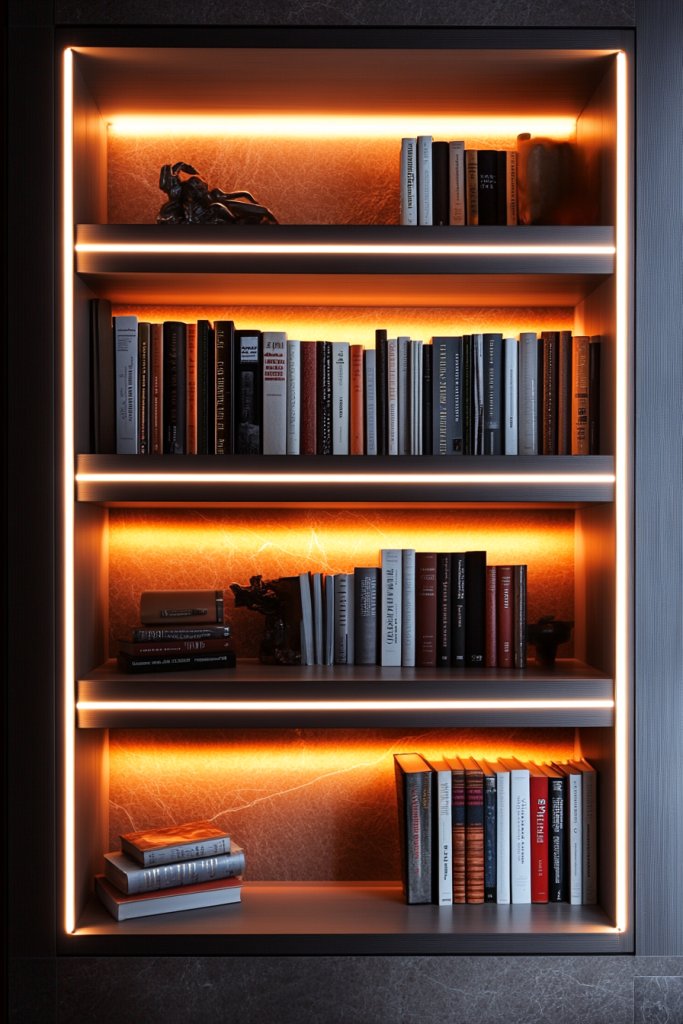
Ever wish certain books or objects could stand out more on your shelf? Using spotlights or LED strips highlights your favorites and adds a dramatic flair. It creates focal points that draw visitors’ eyes and adds a layer of sophistication. Lighting isn’t just functional; it’s a decor game-changer.
Imagine a soft glow illuminating a prized hardcover or a themed collection. The light accentuates textures and colors, making your display pop. You can direct light onto specific books or objects, creating a gallery-like effect. The ambient lighting adds warmth and depth, transforming your shelf into a visual centerpiece.
Use small, adjustable LED puck lights, strip lights, or clip-on spotlights depending on your shelf design. For versatility, choose dimmable options that let you set the mood. Install lighting discreetly behind or underneath shelves for a seamless look. Match the light color to your room’s palette—warm for cozy, cool for modern.
Determine which items to highlight and plan your lighting layout accordingly. Secure the fixtures with appropriate mounts or adhesive strips, ensuring they are stable and unobtrusive. Connect the lighting to a power source, and use smart controls or dimmers for easy adjustment. Test different angles and intensities to achieve the desired effect. Keep wiring tidy and out of sight.
Customize the lighting with colored filters or adjustable brightness levels. Use it to emphasize specific themes or collections. Pair the lighting with decorative shelf liners or textured backdrops for added impact. Regularly update the lighting setup to match your evolving collection or decor changes.
Highlighting your favorite books makes your shelf a curated gallery, elevating your space instantly. It showcases your prized possessions and adds visual interest. Once you see how lighting transforms your display, you’ll be inspired to experiment more and push your decor boundaries.
11. Incorporate Natural Elements like Burl Wood or Stone
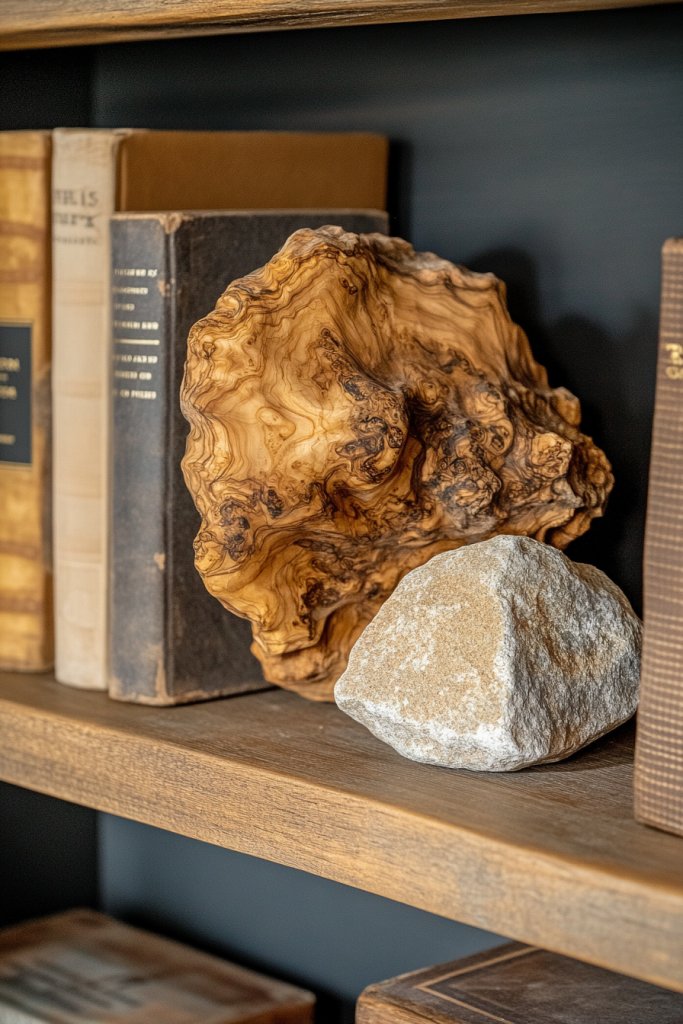
Looking to add warmth and texture to your living room? Natural materials like burl wood or stone bring an organic touch that elevates any decor style. They create a grounded, earthy vibe that contrasts beautifully with the often glossy covers of books. Who wouldn’t want a bit of nature indoors?
Visualize a shelf adorned with a rough-hewn wooden box, stone accents, or textured clay objects nestled among your books. The natural grains and textures add tactile interest and depth. These elements soften sharp lines and bring warmth, making your space feel cozy and inviting. The juxtaposition of natural and manufactured materials creates a balanced aesthetic.
Choose rough or polished finishes depending on your preferred style—rustic, modern, or eclectic. Incorporate reclaimed wood or locally sourced stones for authenticity. Use natural elements as bases for small sculptures or as standalone decor pieces. Mix with textiles like linen or wool for layered textures. Seasonal accessories, like pinecones or dried botanicals, can enhance the natural vibe.
Select durable, lightweight natural elements that are easy to incorporate. Place stones or wooden objects at strategic points for visual weight and balance. Secure fragile pieces with non-permanent adhesives if necessary. Combine natural textures with your books—stack them against a burl wood panel or use a stone slab as a shelf top for a custom look. Maintain with gentle cleaning to preserve their natural beauty.
Personalize with engraved or painted details on wooden pieces. Use textured fabrics or woven baskets nearby to echo natural textures. Pair natural elements with greenery if you decide to include plants, but keep these minimal and carefully chosen. The goal is to evoke calm and connection to nature.
Natural accents foster a peaceful, grounded atmosphere in your home. They showcase your appreciation for organic beauty and craftsmanship. Once you incorporate these elements, you’ll find your space feels more authentic and inviting, inspiring you to continue blending natural textures into your decor.
12. Arrange Books in Asymmetrical or Creative Patterns

Bored of uniform, predictable shelves? Breaking out of symmetry with asymmetrical arrangements creates visual interest and a modern edge. It adds personality and energy to your living space, making your bookshelf a statement piece. Ready to ditch the boring?
Picture a shelf where books are stacked both vertically and horizontally in a seemingly random, yet artful pattern. Some are angled, others are lying flat with objects on top. This playful chaos draws the eye and invites closer inspection. The varied orientations add depth, shadows, and a sense of movement.
Mix book sizes and colors for a dynamic look, or keep a consistent color palette for a more curated vibe. Combine stacks with decorative objects or framed photos at different angles to maintain balance. Use this technique in small doses—just a section or a few shelves—to avoid visual overload. Adjust the pattern seasonally or whenever your collection changes.
Start by laying out your arrangement on the floor or a blank surface. Mix horizontal stacks with vertical rows, balancing the visual weight. Use books of varying sizes for contrast. Tuck in small objects or decorative accents between stacks for added interest. Secure unstable stacks with non-slip pads or gentle adhesives if needed. Keep the overall composition balanced and intentional.
Play with color blocking or thematic groupings to unify the look. Incorporate textured objects or small artworks to complement the asymmetry. Swap items out periodically to refresh the display and keep it lively. Use lighting or backdrops to highlight focal points within the arrangement.
Asymmetrical arrangements challenge traditional notions of order and showcase your creativity. They make your shelves more lively and engaging, encouraging you to think outside the box. Once you see how a little chaos can turn into stunning decor, you’ll be inspired to experiment more and develop your unique style.
13. Incorporate Small Indoor Plants in Non-Green, Stylish Planters
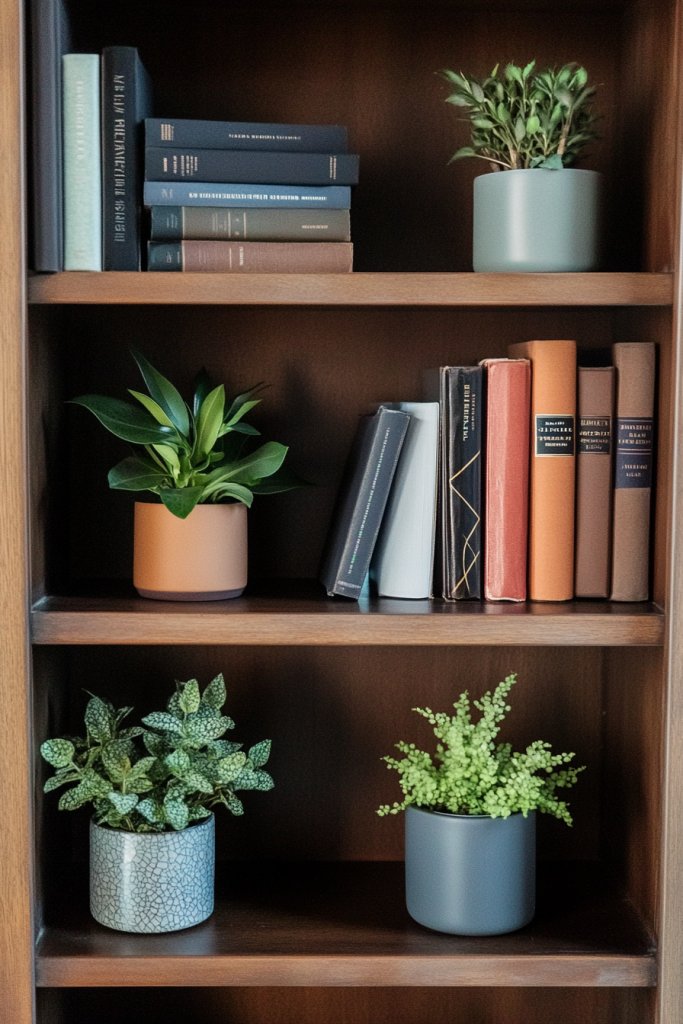
Want a touch of nature without the maintenance of lush greenery? Small indoor plants in stylish planters offer a subtle organic vibe that’s easy to care for. They add a dash of freshness and texture to your bookshelf without overwhelming your decor. Who says plants have to be green to be beautiful?
Visualize tiny succulents, cacti, or air plants in sleek, modern ceramic or textured concrete pots nestled among your books. The contrast of soft shapes and geometric planters creates a balanced, contemporary look. The plants’ subtle presence adds life and a hint of color without requiring much upkeep. Their small size makes them perfect for tight spaces.
Choose planters in neutral tones, metallic finishes, or bold colors to match your decor. Group a few different types of succulents to create visual interest, or keep it minimal with one statement piece. Change out the plants seasonally—like switching to dried arrangements or faux succulents for low-maintenance options. Use different heights and shapes to introduce variety.
Select small, low-maintenance plants suited for indoor environments. Use well-draining soil and ensure proper watering routines—succulents love neglect, after all. Place the planters at varying heights or angles to add dimension. Secure lightweight pots with adhesive pads if needed. Keep the placement away from direct sunlight or drafts to prolong their lifespan.
Decorate planters with paint, decals, or textured finishes for a custom look. Incorporate decorative stones or sand for added detail. Match the plant pots to your room’s color scheme or theme. Rotate or swap plants as your style evolves, keeping the shelf fresh and lively.
These small plants bring a subtle touch of life and personality to your decor. They demonstrate that nature can be integrated effortlessly into modern spaces. Once you see how easy they are to care for, you’ll feel more confident experimenting with other natural elements in your home.
14. Use Colorful or Artistic Storage Baskets for Organization
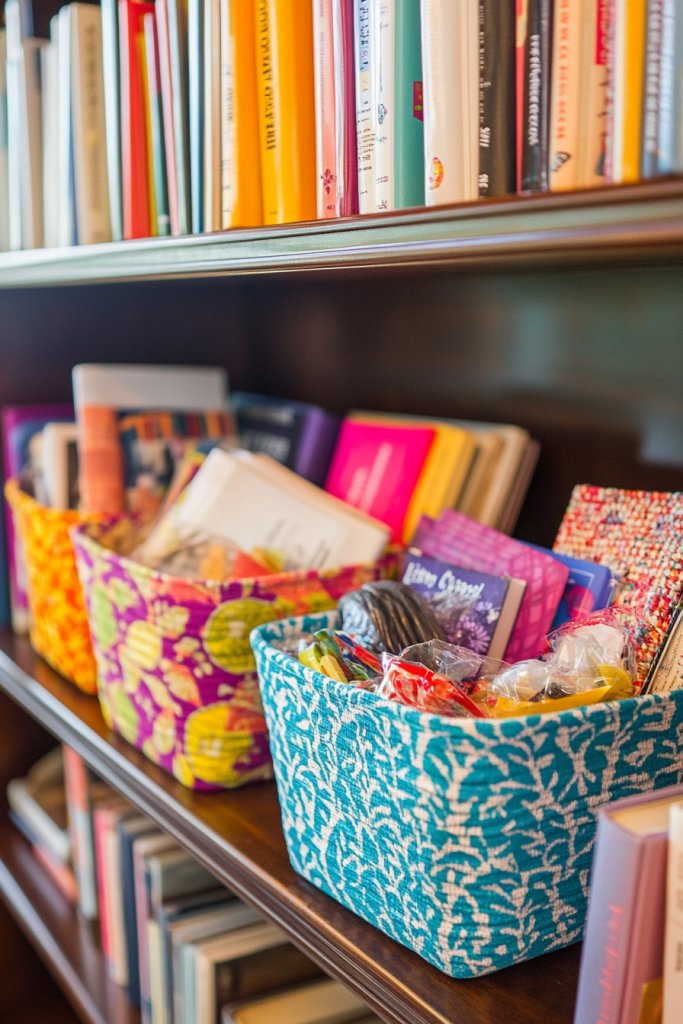
Clutter can ruin even the most stylish shelves, but hiding items in plain sight with colorful baskets is a game-changer. They add pops of color and texture, turning storage into a design feature. Who says organization can’t be beautiful?
Imagine a row of woven or fabric baskets in bold hues or intricate patterns nestled on the lower shelves, holding miscellaneous items. Their vibrant colors contrast with neutral books and wall tones, creating visual interest. When not in use, they add a decorative layer that complements your overall decor style.
Choose baskets that match your color palette or go for contrasting shades for a playful look. Use different textures—rattan, canvas, or velvet—to add tactile variety. Incorporate labels or tags for easy access and a tidy appearance. Seasonal or themed baskets can be swapped out for added flexibility.
Select baskets of appropriate size and durability for your needs. Place frequently used items inside for easy access, keeping the visual clutter hidden. Mix and match colors and textures to create a balanced look. Consider stacking or nesting smaller baskets inside larger ones for extra organization. Regularly tidy up to maintain the aesthetic.
Add decorative trims, embroidery, or painted designs to plain baskets for a personal touch. Pair with matching storage containers or decorative boxes. Use the baskets to create thematic groupings—like travel, fashion, or hobbies—adding coherence. Incorporate a few decorative objects on top of or beside the baskets for extra flair.
Colorful storage baskets turn clutter hiding into a stylish statement. They make your shelf look intentional and vibrant, boosting your confidence in organizing creatively. Once you see how neat and lively your space becomes, you’ll be inspired to keep experimenting with color and pattern combinations.
15. Layer Books with Art Prints or Minimalist Wall Art
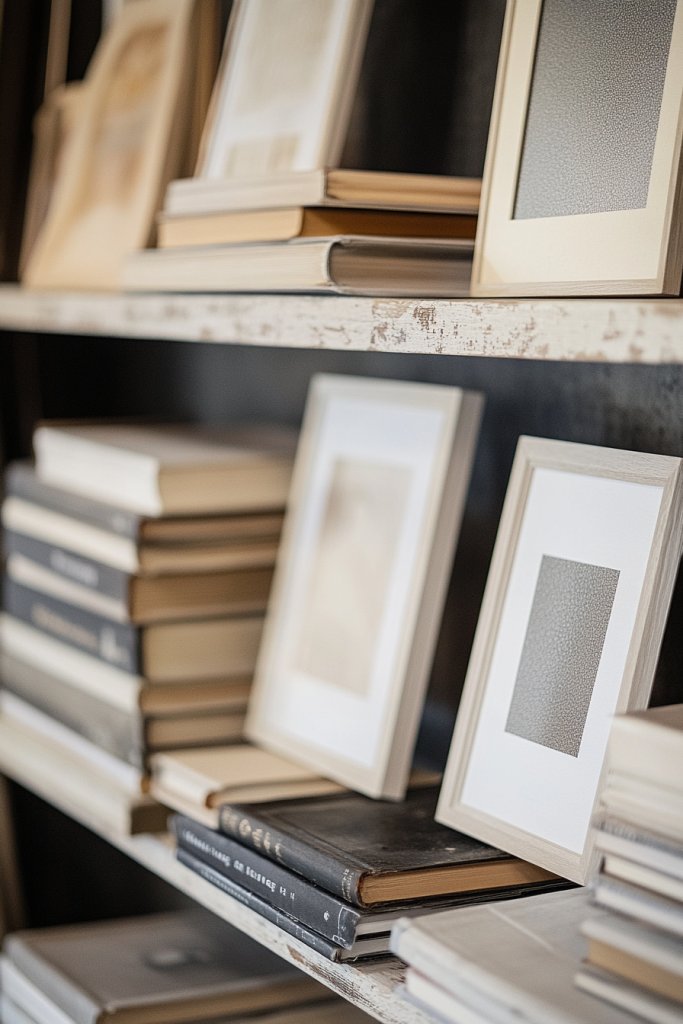
Feeling like your bookshelf is missing that extra punch? Layering books with art prints or minimalist wall art adds depth and personality. It transforms your shelf from simple storage to a curated gallery. Who knew that combining two-dimensional art with three-dimensional books could look so chic?
Picture a shelf where art prints lean against the wall behind a row of books, or are partially tucked into stacks. The interplay of images and books creates a layered, textured look, inviting viewers to explore both elements. This technique adds visual interest and breaks up monotony, making your display more dynamic.
Use framed prints or posters with simple, clean lines for a minimalist vibe. For a more eclectic look, mix different art styles or sizes, layering them at various angles. Change out art seasonally or whenever your decor evolves. Keep the color scheme cohesive to maintain harmony.
Select art prints or posters that complement your decor style. Lean or mount them at an angle against the wall behind your books—no need for permanent fixtures. Incorporate washi tape or removable adhesive if you prefer a more secure setup. Arrange your books and art in a balanced way, considering focal points and flow. Adjust as needed for visual balance.
Add personal touches with custom frames or decorative borders. Mix in textured papers or fabric mats to add depth. Pair the layered art with decorative objects or textured fabrics on adjacent shelves. Rotate art pieces to keep the display fresh and aligned with your evolving style.
Layering books with art elevates your decor into a personal gallery, showcasing your style and taste. It encourages experimentation and adds a sophisticated, curated feel. Seeing your shelves as mini art installations will inspire you to explore more creative arrangements across your home.
16. Incorporate Tiered or Ladder-Style Shelving for Visual Depth
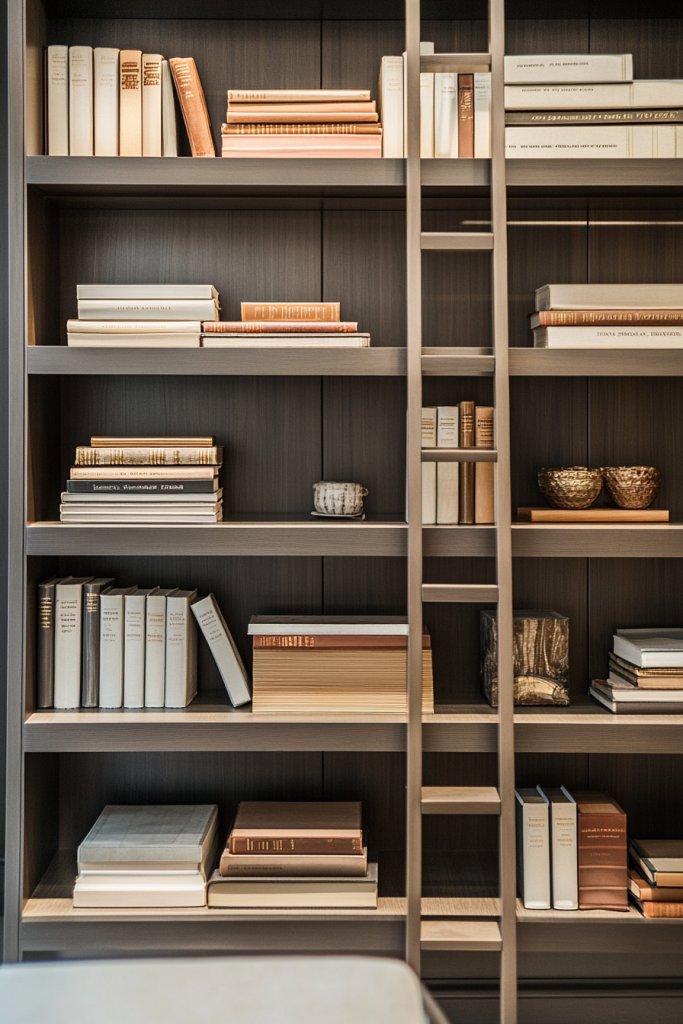
Flat shelves can sometimes look dull or fail to showcase your collection effectively. Tiered or ladder-style shelving adds height and dimension, creating a striking visual impact. It brings a sense of architectural interest to your living space, making your books and decor pop. Ready to add some vertical drama?
Visualize a multi-level ladder shelf leaning against the wall, with books and decorative objects arranged at different heights. The staggered levels create a dynamic composition, emphasizing depth and movement. This setup also allows you to display larger items on the bottom while keeping smaller objects at eye level for maximum effect.
Choose wood or metal ladder shelves for different aesthetics—rustic, industrial, or modern. Use the tiers to organize by color, size, or theme, creating visual harmony. For small spaces, a single ladder can serve as a focal point, while multiple units can define zones in larger rooms. Swap items seasonally or when updating your decor.
Position the ladder shelf at an angle against the wall or mount it securely for stability. Arrange your books and objects thoughtfully across the tiers, balancing visual weight. Use the different levels to tell a story or create focal points. Secure loose items with non-slip pads or gentle adhesives. Keep the display fresh by rotating items regularly.
Decorate the ladder with textiles, small art pieces, or thematic objects that match your decor style. Incorporate lighting—like clip-on LED strips—to highlight each level. Use color coordination or contrasting finishes to make each tier stand out. Personalize with small plants or memorabilia on the top or bottom steps.
Tiered shelving adds architectural interest and showcases your collection in a bold way. It’s versatile and can be tailored to your space and style, making your bookshelf a true focal point. Once you see how this setup elevates your decor, you’ll be eager to explore other structural design ideas.
17. Display Limited Edition or Special Collection Items in Glass Cases
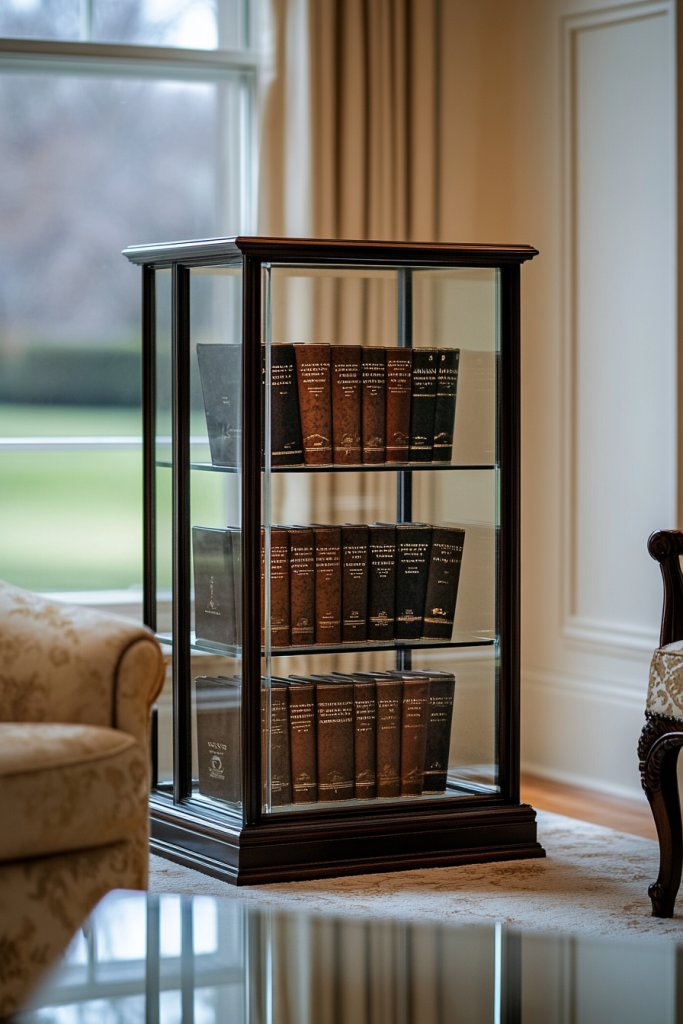
Do you own rare or collectible books that deserve a special spotlight? Displaying limited edition or cherished items in glass cases offers protection and sophistication. It elevates their status and turns your shelf into a mini museum. Who wouldn’t love showcasing their prized possessions?
Visualize a sleek glass display case highlighting a rare signed edition or vintage collection. Light reflects off the glass, drawing attention to the details and craftsmanship. The enclosed environment keeps dust and damage at bay while emphasizing the importance of these items. It’s a perfect blend of preservation and presentation.
Choose cases with clean lines or decorative frames to match your decor. Use them for small collections or single statement pieces. Incorporate lighting inside the case for enhanced visibility. Place the case at eye level or on a prominent shelf for maximum impact. Regularly update the collection or rotate items for variety.
Source high-quality glass cases or shadow boxes suited for your space and collection size. Position them where they can be easily admired—eye level or on a feature wall. Use small supports or stands inside to keep items stable. Ensure proper lighting and ventilation to prevent damage. Keep the area around the case clean and uncluttered.
Add labels or engraved plaques to provide context or details about each item. Incorporate themed backgrounds or subtle decorative elements inside the case. Personalize the display with your own branding or logo if you’re a collector. Periodically update or change the displayed items to maintain interest.
Showcasing special collections in glass cases elevates their importance and adds a luxe touch to your decor. It demonstrates your appreciation for craftsmanship and history. Once you see how elegant and protected your collection looks, you’ll be motivated to expand and refine your display style.
18. Use Vertical Dividers or Partitions to Create Sections

Ever feel overwhelmed by a cluttered, sprawling bookshelf? Vertical dividers or partitions help organize your collection into clear sections, making everything easier to browse. They add structure and symmetry, transforming chaos into order. Who says organizing can’t look stylish?
Imagine a shelf divided into sections with sleek, slim panels that separate genres or topics. Each section becomes a mini display zone, giving your collection a sense of purpose. The divisions create clean lines and visual breaks, making the entire shelf look more intentional and curated. It’s like having multiple mini bookshelves in one.
Use materials like wood, acrylic, or metal for your dividers to match your decor style. Install them at varying heights or widths to accommodate different book sizes. They can be fixed or removable, allowing flexibility in organizing. Seasonal or thematic changes are easy—simply reposition or replace dividers.
Measure your shelf to determine the number and size of dividers needed. Secure them with brackets, screws, or adhesive, ensuring stability. Arrange your books within each section, grouping similar topics or colors. Use labels or signage on dividers for clarity. Regularly update sections as your collection grows or changes.
Decorate dividers with paint, decals, or textured finishes for a personalized touch. Use them to create visual themes—like color blocks or genre zones. Add small decorative elements or lighting near dividers for emphasis. This organization method makes your bookshelf both functional and attractive.
Dividers turn a cluttered shelf into a well-structured showcase. They help you keep your collection in order and make browsing easier. Once you see the clarity and style they bring, you’ll be inspired to organize other areas of your home with similar finesse.
19. Personalize with Handwritten Labels or Book Titles on Spines

Tired of guessing what’s inside each book? Handwritten labels or creatively styled titles on the spines add a personal touch while making your collection easier to browse. It transforms your bookshelf into a customized library that reflects your personality. Who said labeling can’t be stylish?
Imagine a shelf where each book’s spine features a handwritten title in a unique font or style—doodles, calligraphy, or thematic lettering. The personal touches add charm and character, making the display feel curated and intentional. It’s a playful way to infuse your own personality into your decor.
Use colorful pens, metallic markers, or chalk to create labels that match your decor palette. For a vintage look, create faux leather or textured paper labels attached with string or clips. Change or update titles seasonally or when your collection shifts. Keep the style consistent for a cohesive look.
Write or print labels on quality paper or adhesive labels designed for spines. Attach them neatly to the book edges, ensuring they are straight and secure. For a more artistic approach, hand-letter or doodle directly onto the spine with permanent markers. Use a ruler and level for precision. Regularly refresh or modify labels for variety.
Incorporate decorative elements like stamps, stickers, or metallic accents for additional flair. Use labels to categorize by genre, author, or theme—creating a visual map of your collection. Pair with textured or patterned backgrounds for a layered effect. This adds both function and style.
Personalized labels make your bookshelf uniquely yours and improve ease of access. They show off your creativity and attention to detail, turning a simple storage space into a reflection of your personality. Once you see your organized, styled collection, you’ll be motivated to keep curating with even more flair.
Conclusion
Exploring these diverse living room bookshelf decor ideas opens up endless possibilities to personalize your space. Whether you prefer minimalist elegance or eclectic charm, there’s a concept here to match your style. Embrace these ideas, experiment with your arrangements, and let your bookshelf become a true reflection of your personality and flair. Your perfect living room awaits—start decorating today!
Leave a Reply